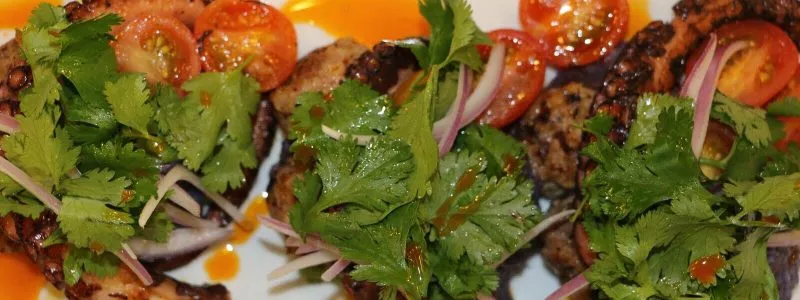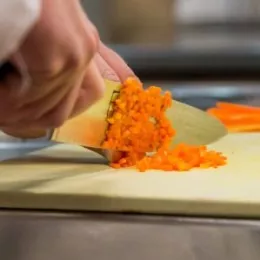Written by Aditya Malhotra, Intensive Sommelier Training Student
Earlier this month, students and alumni enjoyed a star studded masterclass when Chef and Sommelier Pablo Ranea visited ICC’s California campus and world renowned Argentinean wine maker, Santiago Achaval of Matervini Winery, was brought in via a Skype call. During this special event, we had the opportunity to taste a total of ten different wines, and by the end of the day, we gained a new perspective on each of the wines. We started off by sampling 8 Malbecs, each coming from a different elevation, then moved onto a white Torrontes as an aperitif and finished off with a Matervini white.
Argentina is well regarded for its unique culinary style, from quick snacks like empanadas to hearty, quality steaks, and for its high-quality wine produced from ancient vines throughout the country’s varied elevations. During Chef Pablo’s visit, we learned all about Argentina’s cuisine and wine.
 This event was especially impressive because as Chef Pablo introduced each wine, he also did a live cooking demonstration of dishes that would pair well. For his first dish, he showed us an interesting technique designed to soften the structure of the octopus meat which he called “Asustar,” which means “to scare or frighten.” This technique involved holding the octopus by the head and submerging the tentacles into boiling water for only 10-15 seconds and then quickly removing them from the heat; Chef Pablo recommended repeating the process about four times. The completed dish was comprised of the expertly prepared octopus, chorizo and potato puree, and topped with the famous Argentinean Chimichurri sauce.
This event was especially impressive because as Chef Pablo introduced each wine, he also did a live cooking demonstration of dishes that would pair well. For his first dish, he showed us an interesting technique designed to soften the structure of the octopus meat which he called “Asustar,” which means “to scare or frighten.” This technique involved holding the octopus by the head and submerging the tentacles into boiling water for only 10-15 seconds and then quickly removing them from the heat; Chef Pablo recommended repeating the process about four times. The completed dish was comprised of the expertly prepared octopus, chorizo and potato puree, and topped with the famous Argentinean Chimichurri sauce.
 Later on, Chef Pablo demonstrated how to prepare “Pastel de Papa,” which comprises the traditional Empanadas Mendocinas with a skirt steak filling. Chef Pablo noted that cutting the skirt steak prevents the filling from drying out. For this dish, Chef Pablo called for some audience participation. Everyone was pretty excited to roll up their sleeves and learn from the master himself.
Later on, Chef Pablo demonstrated how to prepare “Pastel de Papa,” which comprises the traditional Empanadas Mendocinas with a skirt steak filling. Chef Pablo noted that cutting the skirt steak prevents the filling from drying out. For this dish, Chef Pablo called for some audience participation. Everyone was pretty excited to roll up their sleeves and learn from the master himself.
Pablo Ranea began his career as a Graphic Designer which truly explains the beauty in his food presentation. His preparations looked like art on a plate!
Chef Pablo was the Executive Chef for ten years at The Azafran restaurant, considered to be one of the best restaurants of Mendoza, where he developed his concept of “New Argentinean Cuisine.” It was during his time at Azafran that he also recognized the fact that wines of Argentina were becoming increasingly sophisticated and in higher demand in world markets than ever before. With these thoughts in mind, Chef Pablo saw a need for Argentinean chefs to match their food to great wines. He took matters into his own hands by studying to become a Sommelier, gaining his certification in 2012. Since then, Pablo has been working as a mediating consultant between restaurants and wineries by developing recipes and selecting appropriate wine parings.
In regards to the meaning of “New Argentinean Cuisine,” Pablo explains that he aims to discover contemporary takes on traditional dishes by utilizing a variety of quality regional ingredients. For example, combining lamb that was raised in southern Patagonia, garnished with quinoa harvested from the mountainous region of the Andes, finished with a sauce made with corn or tapioca from the north-east. In this way, pulling ingredients from all corners of Argentina into one dish, Chef Pablo has been able to create a whole new dish which is still exponentially Argentinean.
As a firm believer in the importance of learning from new places, people and experiences, Chef Pablo has become more of a “Nomad Chef,” taking time away from the stationary restaurant setting to travel internationally with his partner Alejandro Cohen. Over the last two years, as they travel the world, they make an effort to share with others their knowledge and passion about Argentinean cuisine and wine by leading cooking demonstrations, wine tastings and hosting pop-up dinners. The students at the ICC were more than honored to have had a chance to meet them.
Check out my tasting notes about the wines from the event below. You may even want to pick up a bottle for yourself!

- Nieto Senetiner- Torrontes 2016, Yellow color with greenish shades. The nose has a bouquet of white flowers, white peach and citrus fruit like orange and grapefruit
- Mi Terruno Reserve- Malbec 2014, Intense red colour with violet hues. Good body with sweet and round tannins. Typical Malbec red fruit aromas of plums and cherry with vanilla notes from the oak aging.
- Don Nicanor, Barrel Select- Malbec 2014, Intense purple-red hue and exquisite fruity notes of cherry and red currant.
- Rutini Encuentro-Malbec, aged 12 months in French and American Oak, violets floral notes, and fresh red and black fruits. Full-bodied tannins and rich dark chocolatey marmalade fruit notes are present on the mouth.
- Guachezco Oro-Malbec 2013 aged 16 months in barrels of French, American and Hungarian oak, displays a deep red colour. The notes of red fruits, plums and blackberries are combined with notes of cranberry along with aromas of caramel, vanilla and mocha from the time spent in the oak.
- Rutini Cabernet Malbec 2013 50% Cabernet Sauvignon, 50% Malbec, 12 Months in French and American Oak. On the nose, full bodied fruit aromas of cherry, marmalade & plum. The mouth feel combines the mature fruit essence with rich spices of vanilla & chocolate from the time in oak.
- Matervini Finca Malbec, grown at 3200 feet of altitude, in alluvial soils. The combination of this soil and old vines results in this classic wine from Mendoza, with flavors of attractive austerity and rich mouth feel at the same time,
- Matervini Antes Andes Valles Calchaquies Malbec, planted at 7800 feet of altitude a distinctive Malbec, fresh and full of fruit, with a wild feeling to it and mineral notes that make it a typical wine from Salta.
- Matervini Blanco, Roussanne, Marsanne and Viognier, cofermented, the juice is allowed 5 days of skin contact prior to fermentation. This decadent white wine has the structure of an old world wine but still had some zesty youth. A great way to finish the tastings.
This blog post was originally published by the International Culinary Center (ICC), founded as The French Culinary Institute (FCI). In 2020, ICE and ICC came together on one strong and dynamic national platform at ICE's campuses in New York City and Los Angeles. Explore your culinary education where the legacy lives on.



